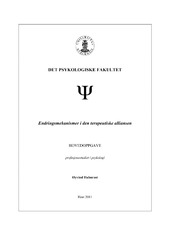| dc.contributor.author | Halmrast, Øyvind | |
| dc.date.accessioned | 2012-08-07T07:13:02Z | |
| dc.date.available | 2012-08-07T07:13:02Z | |
| dc.date.issued | 2011-11-24 | eng |
| dc.date.submitted | 2011-11-24 | eng |
| dc.identifier.uri | https://hdl.handle.net/1956/5901 | |
| dc.description.abstract | The aim of this thesis is to explore potential mechanisms of change in the therapeutic alliance within a historical, empirical and theoretical frame of reference. The thesis argues that the negotiation of alliance ruptures and self-efficacy change are potential mechanism of change, which the alliance operates through. In an effort to illustrate how one can start the construction of a specific conceptual model for how the therapeutic alliance leads to therapeutic change, the thesis integrates relevant theoretical conceptualizations and empirical evidence on the negotiation of alliance ruptures and self-efficacy change. The thesis argues that future research is needed to establish whether or not the alliance has a direct curative effect, and what mechanisms of change the alliance operates through. Future research on mechanisms of change in the alliance should be in line with the criteria outlined by Kazdin and Nock (2003). A complicating element in this process is how factors related to the client, therapist and type of psychotherapy, moderate the effect of mechanisms of change. In the process of demonstrating mechanisms of change in general, it is therefore essential to uncover how these factors moderate the effect of mechanisms of change. | en_US |
| dc.description.abstract | Målet med oppgaven har med utgangspunkt i en historisk, empirisk og teoretisk referanseramme, vært å undersøke potensielle endringsmekanismer i den terapeutiske alliansen. Etter en gjennomgang av relevant teori og empiri, fremstår forhandling av alliansebrudd og endring i self-efficacy som potensielle endringsmekanismer i alliansen. I et forsøk på å skissere hvordan alliansen gir effekt, integreres relevante teoretiske konseptualiseringer av og empirisk evidens for forhandling av alliansebrudd og endring i self-efficacy. Integreringen er et eksempel på hvordan en kan begynne arbeidet med å bygge opp en spesifikk konseptuel modell, for hvordan endringsmekanismer i alliansen opererer for å gi effekt i form av terapeutisk endring. Oppgaven kommer frem til at ytterligere forskning er nødvendig for å kunne si med større sikkerhet at alliansen har en direkte kurativ effekt. Ytterligere forskning er også nødvendig for å avdekke endringsmekanismene i alliansen, hvordan mekanismene kan aktiveres, og hvordan mekanismene opererer for å gi effekt i form av terapeutisk endring. Fremtidig forskning på endringsmekanismer i alliansen bør etterstrebe å innfri de kriteriene Kazdin og Nock (2003) skisserer for å påvise endringsmekanismer. I denne prosessen er et kompliserende element at ulike faktorer knyttet til klient, terapeut og behandlingsform, modererer effekten av endringsmekanismene. I arbeidet med å avdekke mekanismer, blir det derfor av vesentlig betydning å også avdekke hvordan modererende faktorer påvirker effekten av mekanismene. | en_US |
| dc.format.extent | 431728 bytes | eng |
| dc.format.mimetype | application/pdf | eng |
| dc.language.iso | nob | eng |
| dc.publisher | The University of Bergen | eng |
| dc.title | Endringsmekanismer i den terapeutiske alliansen | eng |
| dc.type | Master thesis | |
| dc.rights.holder | Copyright the author. All rights reserved | |
| dc.description.localcode | PSYK300 | |
| dc.description.localcode | PRPSYK | |
| dc.subject.nus | 736102 | eng |
| dc.subject.nsi | VDP::Social science: 200::Psychology: 260 | eng |
| fs.subjectcode | PSYK300 | |
